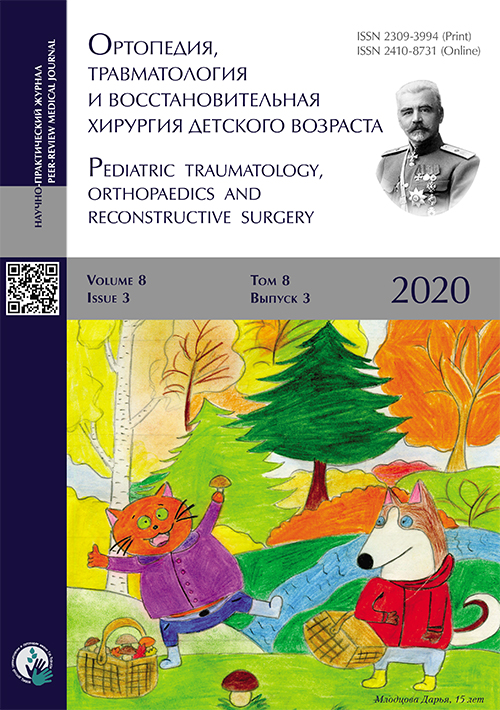青少年特发性脊柱侧凸患者色努支具治疗结束时的脊柱畸形情况
- 作者: Tsaknakis K.1, Braunschweig L.1, Lorenz H.M.1, Hell A.K.1
-
隶属关系:
- University Medical Center Goettingen
- 期: 卷 8, 编号 3 (2020)
- 页面: 269-274
- 栏目: Original Study Article
- ##submission.dateSubmitted##: 11.05.2020
- ##submission.dateAccepted##: 03.08.2020
- ##submission.datePublished##: 06.10.2020
- URL: https://journals.eco-vector.com/turner/article/view/34039
- DOI: https://doi.org/10.17816/PTORS34039
- ID: 34039
如何引用文章
详细
背景:支具常用于治疗青少年特发性脊柱侧凸(AIS)。但因支具型号各异,色努(Chêneau)支具治疗脊柱畸形结束后的远期疗效鲜有报道,并且效果也不尽相同。
目的本研究旨在分析AIS患者从色努支具治疗开始至骨骼生长及治疗结束期间的临床及放射学数据,
以确定色努支具在患者日常生活中的实际治疗结果和预期效果。
材料和方法。追踪观察色努支具治疗开始至骨骼生长结束期间52例AIS患者的情况。分析初始Risser征、
治疗时的年龄、性别、侧凸趋势和身体质量指数等临床数据。
结果。开始行支具治疗时,患者的平均年龄为13.1岁,平均侧凸角度为30.9°。支具治疗4个月时,
侧凸角度减小至20.1°。在支具治疗结束9个月后,平均治疗时间为17个月,侧凸角度又回升至30.3°。
对于发育成熟程度较低的患儿,初始侧凸角度小于发育成熟程度较高的患儿,故在治疗结束时,脊柱畸形问题较少。此外,在支具治疗期间,肥胖患儿脊柱侧凸的矫正程度低于正常体重的患儿。
结论。经色努支具治疗,AIS患者的初始侧凸矫正率为35%。在支具治疗结束9个月后,发现侧凸程度与治疗开始时的畸形程度相同。
全文:
支具常用作青少年特发性脊柱侧凸(AIS)的治疗方案,从而预防侧凸加重及其不良影响,避免行脊柱融合术[1]。
然而,目前难以比较骨骼生长结束时和保守治疗结束后的效果。治疗效果受到支具设计的影响,而支具设计很大程度上取决于不同地区的偏好[2]。同行评议论文大多集中于北美支具治疗[3, 4]。因此,文献大量描述并对比了Milwaukee[5]、Boston[6]、
Providence[7]和Charleston[8]支具。
欧洲主要使用色努(Chêneau)或类
似色努的支具,如Chêneau-Rigo[9]
或ScoliOlogiC®色努之光(“Chêneau light”)[10]。近数十年来,相较于美国支具,描述该类支具的结果较少
[1, 11, 12],报道的支具治疗结束后达到的矫正结果也千差万别。
除了支具类型,治疗结果在很大程度上还取决于具体支具制造情况、初始侧凸矫正情况[12, 13]、支具佩戴时间[14]以及生长速率峰值、剩余生长能力、初始侧凸
角度、侧凸僵硬程度等许多与患者自身有关的因素。
目的本研究旨在分析AIS患者从色努支具治疗开始至骨骼生长及治疗结束期间的临床及放射学数据,以确定色努支具在患者日常生活中的实际治疗结果和预期效果。
材料和方法
经大学医学中心(University Medical Center)机构伦理审查委员会审批,追踪观察来自同一家大学医学中心、由接受色努支具保守治疗的52例AIS患者组成的队列,
从其治疗开始至骨骼生长结束期间以及支具治疗结束几个月(平均9个月)后的情况。根据Richards等人在[15]国际脊柱侧凸研究学会(SRS)发表的支具研究,开始支具治疗的纳入标准如下:经诊断患有AIS、
最小年龄10岁、Risser征0级至2级(放射片
示髂骨突出骨化<50%)、侧凸角度(Cobb角)
介于25°和40°之间、初潮不到1年、既往
未经治疗。本研究纳入的患者符合上述
标准,且接受了色努支具治疗,直至骨骼生长结束(Risser征5级)。此外,本研究还纳入了14例侧凸角度在17°至24°之间的患者,因为在德国支具治疗适用于侧凸角度为20°的患者,且使用Cobb法时,应当考虑5°的测量误差。记录侧凸趋势和身体质量指数等临床数据。第一次访视时统一拍摄标准放射站立位正位(AP)和侧位片,
进行分析。为减少射线照射,后续摄片时仅取AP站立位(图1)。
图 1 1例12岁男性脊柱侧凸患儿(a),矢状位正常(b)。色努支具能够很好地矫正其脊柱侧凸 问题(c)。支具治疗结束后为期6个月的随访期内,脊柱畸形程度约等于初始水平(d)
所有患者使用的色努支具,由来自全国各地的公司制造。支具制造完成后,随着佩戴时间的增加,建议进行一段时间的磨合。必要时,由制造商对该矫形器进行调整。
首次访视3至5个月后,安排门诊访视,检查支具,在佩戴支具的情况下拍摄正位片,
检查畸形矫正效果。嘱所有青少年患者及其家长,每天佩戴支具23个小时[14],
仅在运动和淋浴期间摘除。给予物理治疗,多用Schroth疗法,在三维平面内固定、
稳定和伸长脊柱[16]。未收集支具实际佩戴时间和物理治疗情况等客观数据。因此,
本研究报告的数据代表了一家大型儿科脊柱诊所内患者典型的日常状况。
除了临床数据外,在佩戴和未佩戴色努支具的情况下,分别对脊柱侧凸进行X线成像测定。根据发育成熟程度(Risser征)
分析数据。采用Lenke分型,描述3个脊柱
区域(近胸、主胸和胸腰/腰)是结构弯还是非结构弯,借助X线片可将脊柱侧凸分为6种不同的类型[18]。运用Excel对收集的数据进行t检验统计分析。所有数据以均值±标准差表示。p < 0.05(*)时,
具有统计显著性。
结果
根据SRS标准[15],对52例特发性脊柱侧凸患儿的临床数据和放射学影像进行
评估。在所有患儿中,88%(n = 46)为女,
12%(n = 6)为男。诊断时的平均年龄为13.1岁(11.1岁-14.3岁,SD = 1.63)。诊断时和支具治疗开始时的平均身高为162 cm,平均体重为49 kg。研究组中87%(n = 45)的患者为单弯,其他(n = 7)经诊断患有S形双弯,因此本研究共分析59条侧弯。
运用Lenke分型法[17]将脊柱侧凸分为
6种不同的类型。大多数患者主要属于
Lenke 1型(右侧胸椎主侧凸)(见表)。
Lenke分型 | ||
1 | n = 27 | 52% |
2 | n = 0 | 0% |
3 | n = 7 | 13% |
4 | n = 3 | 6% |
5 | n = 14 | 27% |
6 | n = 1 | 2% |
患者发育成熟程度各异。48%(n = 22)的女性患儿已发生初潮。其中75%的患儿初步诊断为Risser征≥1级。2%的放射片由于技术原因无法评估Risser征。
AIS患者放射片表明色努支具治疗开始时的平均侧凸角度为30.9°,治疗4个月后可减小至20.1°,即初始侧凸矫正率达到35%。
支具治疗期间行最后一次放射学检查发现,
在平均为期17个月的治疗过程中,平均侧凸角度已增加至26.3°。但这一差异不具有统计显著性(图2)。在支具治疗结束
9个月后,侧凸角度与初始水平相同。
图 2 所有患者(n = 5 2 ) 的主要侧凸角度 (单位:度;均值±标准差),包括出现支具治 疗指征时、佩戴支具4个月后、最后一次支具调试 (17个月)、支具治疗结束9个月后的侧凸角度。 以t检验计算显著性水平(* p < 0.05),得出初 始值(支具治疗指征)
就剩余生长能力而言,患者达到生长速率峰值(Risser征≥1级)后,侧凸更加
严重(33.5°对比23.4°,p = 0.005),
但治疗期间表现出的侧凸趋势与骨骼发育更加成熟的患者相同(图3)。
图 3 骨骼发育不成熟(Risser征0级)与骨骼发 育成熟(Risser征≥1级)患者的侧凸趋势差异 (单位:度;均值±标准差)。对51例患者进行 分析。运用t检验得出的显著性水平(* p < 0.05) 与两组间的差异有关
数据分析表明,超重是色努支具矫正脊柱畸形的不良预测因素。在支具治疗过程中,
相较于体重正常的青少年患者,超重患者(n = 4,身体质量指数[BMI]>90分位数)的初始侧凸角度(41°对比31°)和最终侧凸角度(46°对比26°)更大,畸形矫正效果更差(p = 0.039)。
讨论
支具对AIS患儿的疗效依然充满争议。
一项仅针对英语文献的系统研究表明[3],
接受手术治疗的AIS患者与使用支具的AIS患儿在侧凸角度方面不存在差异。与此
相反,在另一项研究中,AIS患儿支具治疗的成功率比仅接受观察的患儿更高[18]。
De Giorgi等人[1]报告,色努支具治疗结束5年后的永久脊柱侧凸矫正率为59%,平均侧凸角度为11°,因此并无手术指征。
AIS支具治疗存在很多问题:支具类型、具体制造情况、佩戴时间不一[19, 20]、
其他物理治疗不同、个体侧凸进展和僵硬程度、剩余生长能力等许多其他因素。
如De Giorgi等人在2013年所述[1],色努支具满足以下条件时才很有可能达到极佳的治疗
效果:谨慎筛选患者;从始至终仅有一位治疗医师,亲自负责调试所有支具,监督佩戴
时间;给予物理治疗;支具仅来自一家经验丰富的制造商。但在大多数情况下,这通常无法全部实现。本研究报告了一家大型儿科脊柱治疗中心门诊日常环境下的常规治疗效果。
按照SRS标准筛选患者后[15],我们为青少年患者配备了欧洲常见的色努支具[10]。许多家庭住得离治疗中心较远,因此我们选择了当地制造商。治疗开始后,平均每
4.3个月拍片,对支具给予调试。一项研究表明,理想侧凸矫正率最低为50%[12, 13],
但在本研究群体中,仅能达到35%。其中一个原因可能是参与生产色努支具的制造商
不同,使用的工艺也有差别。建议家长根据拍片结果在其当地制造商处调试色努
支具,改善矫正效果。建议每6个月进行一次
复查,如若发现问题,则应更早前去复查。
在色努支具治疗过程中,实施上述标准流程后,随着时间的推移,侧凸角度逐渐
增大,但无统计显著性。支具治疗结束
9个月后,脊柱侧凸角度与最初脊柱畸形水平完全相同。Hopf等人[11]和Zaborowska-Sapeta等人[21]也报告了类似的发现,后者
称48%的患者侧凸不再进展。支具疗程结
束后,其远期疗效千差万别。有些研究称达到了极佳的永久疗效[1],而其他研究表明随着时间的推移侧凸逐渐进展[21, 22]。
在本研究中,有些患者在开始治疗时骨骼发育不成熟(Risser征<0级),因此经过长时间治疗后,最终侧凸程度并未比治疗开始时骨骼发育更成熟的患者更严重
(图3)。其中一个原因可能是本研究是选择患者的依据是SRS标准[15],因而排除了10岁以下的患儿,这类患儿的侧凸进展一般更加严重。与色努支具疗效较差有关的消极因素是明显超重,这一点在既往文献中已有提及[23]。
研究局限性
本研究的局限性如下,由于支具治疗在德国适用于脊柱侧凸20°的患者,故本研究按SRS标准纳入了Cobb角低于25°的患者,采用Cobb法时应当考虑5°的测量误差。
结论
本研究分析的52例AIS患儿接受了色努
支具(由全国各地的制造商生产)治疗,
总体初始侧凸矫正率为35%。在骨骼生长结束和支具治疗结束后9个月的随访期发现,侧凸程度与治疗开始时的畸形程度相同。
上述结果优于许多美国研究报道[4, 6-8],但劣于报道的下列条件下达到的结果:谨慎筛选患者、仅一位治疗医师、密切监测和支具仅来自一家经验丰富的制造商[1]。
总而言之,通过支具治疗AIS患儿,能够预防病情进展,而非矫正或逆转畸形,而且使得最终的侧凸角度等于初始水平。
其他信息
经费来源:本研究无经费支持。
利益冲突:所有作者声明,不存在利益冲突。
伦理声明:2013年12月05日,当地伦理委员会审批通过,编号DOK_125_2013。
由于本研究仅评估放射学影像,伦理委员会豁免了知情同意书。已告知参与者本研究的目的,并且所有患者的摄片都得到了其父
母和/或法定监护人的知情同意。
作者贡献
K. Tsaknakis和A.K. Hell——负责研究构思与设计、收集数据、分析和阐释数据、撰写及修订文稿。
H.M. Lorenz——负责收集数据和修订
文稿。
L. Braunschweig——分析和阐释数据、撰写及修订文稿。
所有作者对本文的研究及准备工作做出了重要贡献,且在出版前阅读并批准了最终版本。
作者简介
Konstantinos Tsaknakis
University Medical Center Goettingen
Email: konstantinos.tsaknakis@med.uni-goettingen.de
ORCID iD: 0000-0002-7102-5892
MD, Pediatric Orthopaedics, Department of Trauma, Orthopaedic and Plastic Surgery
德国, GoettingenLena Braunschweig
University Medical Center Goettingen
Email: lena.braunschweig@med.uni-goettingen.de
MD, PhD, Pediatric Orthopaedics, Department of Trauma, Orthopaedic and Plastic Surgery
德国, GoettingenHeiko Lorenz
University Medical Center Goettingen
Email: heiko.lorenz@med.uni-goettingen.de
MD, Pediatric Orthopaedics, Department of Trauma, Orthopaedic and Plastic Surgery
德国, GoettingenAnna Hell
University Medical Center Goettingen
编辑信件的主要联系方式.
Email: anna.hell@med.uni-goettingen.de
ORCID iD: 0000-0002-6655-7130
MD, Pediatric Orthopaedics, Department of Trauma, Orthopaedic and Plastic Surgery
德国, Goettingen参考
- De Giorgi S, Piazzolla A, Tafuri S, et al. Cheneau brace for adolescent idiopathic scoliosis: long-term results. Can it prevent surgery? Eur Spine J. 2013;22 Suppl 6: S815-822. https://doi.org/10.1007/s00586-013-3020-1.
- Katz DE, Herring JA, Browne RH, et al. Brace wear control of curve progression in adolescent idiopathic scoliosis. J Bone Joint Surg Am. 2010;92(6):1343-1352. https://doi.org/10.2106/JBJS.I.01142.
- Dolan LA, Weinstein SL. Surgical rates after observation and bracing for adolescent idiopathic scoliosis: an evidence-based review. Spine (Phila Pa 1976). 2007;32(19 Suppl):S91-S100. https://doi.org/10.1097/BRS.0b013e318134ead9.
- Schiller JR, Thakur NA, Eberson CP. Brace management in adolescent idiopathic scoliosis. Clin Orthop Relat Res. 2010;468(3):670-678. https://doi.org/10.1007/s11999-009-0884-9.
- Lonstein JE, Winter RB. The Milwaukee brace for the treatment of adolescent idiopathic scoliosis. A review of one thousand and twenty patients. J Bone Joint Surg Am. 1994;76(8):1207-1221. https://doi.org/10.2106/00004623-199408000-00011.
- Katz DE, Durrani AA. Factors that influence outcome in bracing large curves in patients with adolescent idiopathic scoliosis. Spine (Phila Pa 1976). 2001;26(21):2354-2361. https://doi.org/10.1097/00007632-200111010-00012.
- D’Amato CR, Griggs S, McCoy B. Nighttime bracing with the Providence brace in adolescent girls with idiopathic scoliosis. Spine (Phila Pa 1976). 2001;26(18):2006-2012. https://doi.org/10.1097/00007632-200109150-00014.
- Price CT, Scott DS, Reed FR, et al. Nighttime bracing for adolescent idiopathic scoliosis with the Charleston Bending Brace: Long-term follow-up. J Pediatr Orthop. 1997;17(6):703-707.
- Rigo M, Weiss H-R. The Chêneau concept of bracing — biomechanical aspects. Stud Health Technol Inform. 2008;135:303-319.
- Grivas TB, Kaspiris A. European braces widely used for conservative scoliosis treatment. Stud Health Technol Inform. 2010;158:157-166.
- Hopf C, Heine J. Long-term results of the conservative treatment of scoliosis using the Cheneau brace. Z Orthop Ihre Grenzgeb. 1985;123(3):312-322. https://doi.org/10.1055/s-2008-1045157.
- Weiss HR, Werkmann M. “Brace Technology” Thematic Series — The ScoliOlogiC(R) Cheneau light brace in the treatment of scoliosis. Scoliosis. 2010;5:19. https://doi.org/10.1186/1748-7161-5-19.
- Jonasson-Rajala E, Josefsson E, Lundberg B, Nilsson H. Boston thoracic brace in the treatment of idiopathic scoliosis. Initial correction. Clin Orthop Relat Res. 1984;(183):37-41.
- Rowe DE, Bernstein SM, Riddick MF, et al. A meta-analysis of the efficacy of non-operative treatments for idiopathic scoliosis. J Bone Joint Surg Am. 1997;79(5):664-674. https://doi.org/10.2106/00004623-199705000-00005.
- Richards BS, Bernstein RM, D’Amato CR, Thompson GH. Standardization of criteria for adolescent idiopathic scoliosis brace studies: SRS Committee on Bracing and Nonoperative Management. Spine (Phila Pa 1976). 2005;30(18):2068-2075; discussion 2076-2067. https://doi.org/10.1097/01.brs.0000178819.90239.d0.
- Lehnert-Schroth C. Schroth’s three dimensional treatment of scoliosis. ZFA (Stuttgart). 1979;55(34):1969-1976.
- Lenke LG, Betz RR, Harms J, et al. Adolescent idiopathic scoliosis: A new classification to determine extent of spinal arthrodesis. J Bone Joint Surg Am. 2001;83(8):1169-1181.
- Weinstein SL, Dolan LA, Wright JG, Dobbs MB. Effects of bracing in adolescents with idiopathic scoliosis. N Engl J Med. 2013;369(16):1512-1521. https://doi.org/10.1056/NEJMoa1307337.
- Donzelli S, Zaina F, Negrini S. In defense of adolescents: They really do use braces for the hours prescribed, if good help is provided. Results from a prospective everyday clinic cohort using thermobrace. Scoliosis. 2012;7(1):12. https://doi.org/10.1186/1748-7161-7-12.
- Karol LA, Virostek D, Felton K, et al. The Effect of the risser stage on bracing outcome in adolescent idiopathic scoliosis. J Bone Joint Surg Am. 2016;98(15):1253-1259. https://doi.org/10.2106/JBJS.15.01313.
- Zaborowska-Sapeta K, Kowalski IM, Kotwicki T, et al. Effectiveness of Cheneau brace treatment for idiopathic scoliosis: Prospective study in 79 patients followed to skeletal maturity. Scoliosis. 2011;6(1):2. https://doi.org/10.1186/1748-7161-6-2.
- Aulisa AG, Guzzanti V, Falciglia F, et al. Curve progression after long-term brace treatment in adolescent idiopathic scoliosis: Comparative results between over and under 30 Cobb degrees — SOSORT 2017 award winner. Scoliosis Spinal Disord. 2017;12:36. https://doi.org/10.1186/s13013-017-0142-y.
- Goodbody CM, Asztalos IB, Sankar WN, Flynn JM. It’s not just the big kids: Both high and low BMI impact bracing success for adolescent idiopathic scoliosis. J Child Orthop. 2016;10(5):395-404. https://doi.org/10.1007/s11832-016-0763-3.
补充文件










